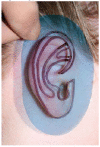Ear Reconstruction Simulation: From Handcrafting to 3D Printing
- PMID: 30764524
- PMCID: PMC6466171
- DOI: 10.3390/bioengineering6010014
Ear Reconstruction Simulation: From Handcrafting to 3D Printing
Abstract
Microtia is a congenital malformation affecting one in 5000 individuals and is characterized by physical deformity or absence of the outer ear. Nowadays, surgical reconstruction with autologous tissue is the most common clinical practice. The procedure requires a high level of manual and artistic techniques of a surgeon in carving and sculpting of harvested costal cartilage of the patient to recreate an auricular framework to insert within a skin pocket obtained at the malformed ear region. The aesthetic outcomes of the surgery are highly dependent on the experience of the surgeon performing the surgery. For this reason, surgeons need simulators to acquire adequate technical skills out of the surgery room without compromising the aesthetic appearance of the patient. The current paper aims to describe and analyze the different materials and methods adopted during the history of autologous ear reconstruction (AER) simulation to train surgeons by practice on geometrically and mechanically accurate physical replicas. Recent advances in 3D modelling software and manufacturing technologies to increase the effectiveness of AER simulators are particularly described to provide more recent outcomes.
Keywords: Computer-Aided Design (CAD); additive manufacturing; autologous ear reconstruction; costal cartilage; image-processing; microtia; silicone rubbers; simulation; training.
Conflict of interest statement
The authors declare that they have no conflict of interest.
Figures










References
-
- Heike C.L., Luquetti D.V., Hing A.V. Craniofacial Microsomia Overview. University of Washington; Seattle, WA, USA: 1993. - PubMed
-
- Ross M.T., Cruz R., Hutchinson C., Arnott W.L., Woodruff M.A., Powell S.K. Aesthetic reconstruction of microtia: A review of current techniques and new 3D printing approaches. Virtual Phys. Prototyp. 2018;13:117–130. doi: 10.1080/17452759.2018.1430246. - DOI
Publication types
LinkOut - more resources
Full Text Sources
Other Literature Sources
Miscellaneous

